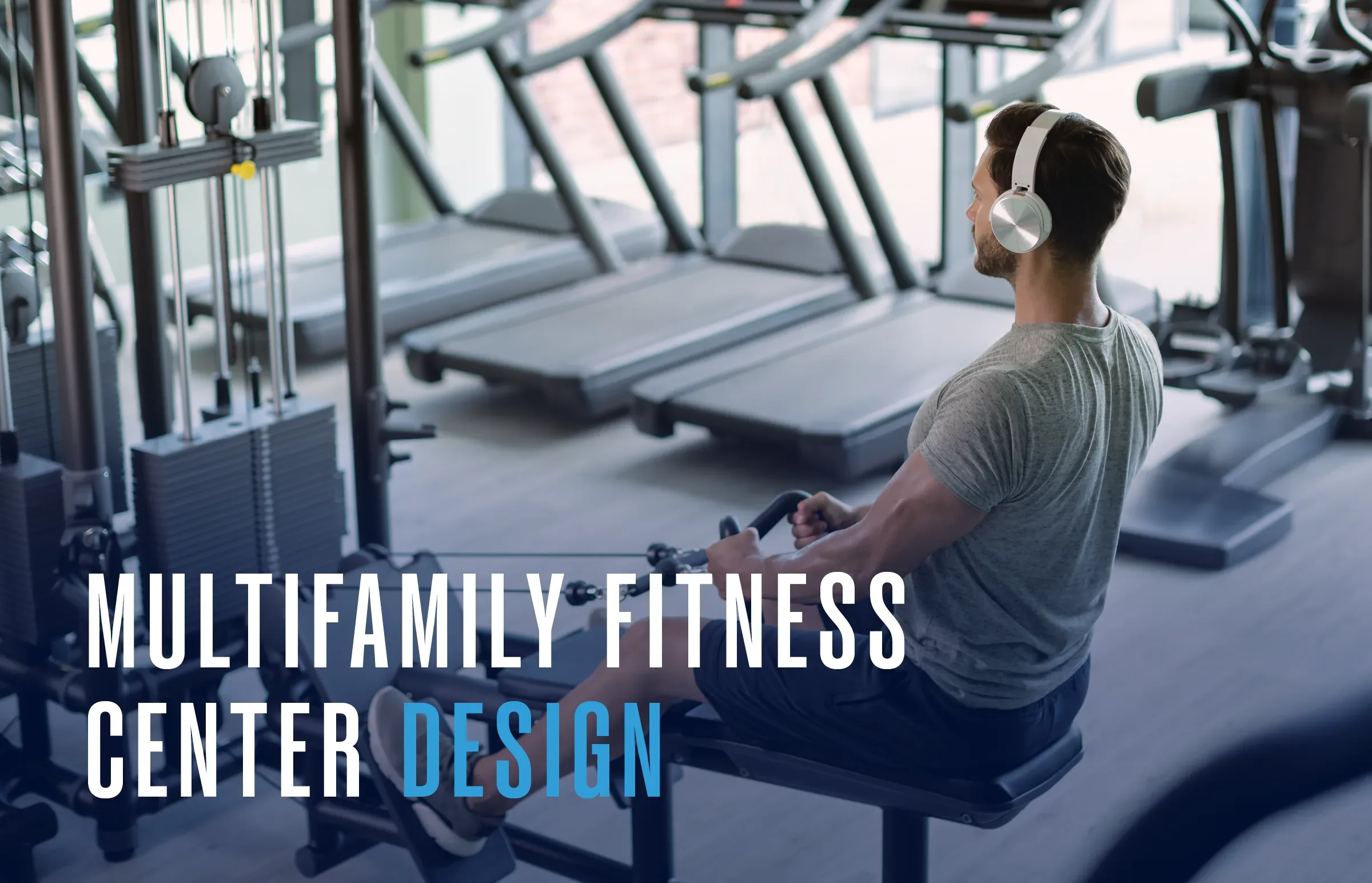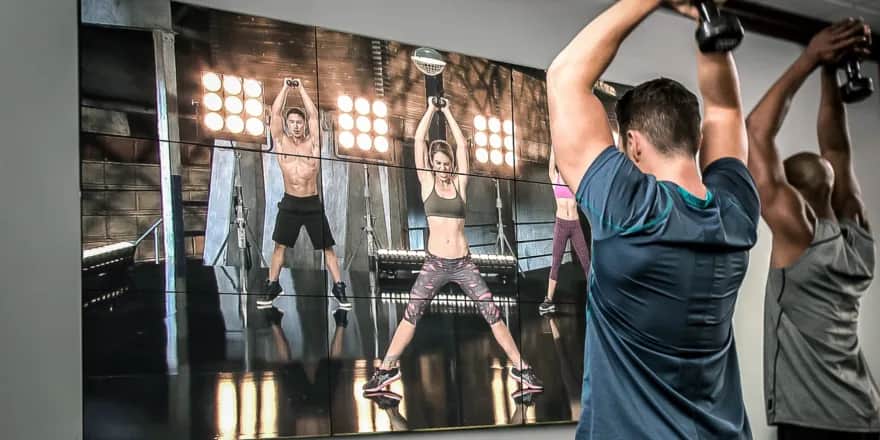In a highly competitive real estate market, providing amenities beyond housing is crucial for property owners to attract and retain residents and tenants. A well-designed multifamily fitness center is one such amenity that can significantly enhance a property’s value while improving the residents’ living experience.

But to achieve this, you need a fitness center design that integrates diverse elements to meet all the residents’ fitness requirements. These include but are not limited to proper space for gym activities and cutting-edge fitness equipment. Such elements help provide an engaging fitness experience for all participants, which improves resident satisfaction, attracts prospective tenants, and increases the property’s demand.
So, let’s understand how to create the perfect multifamily fitness center design.
The Importance of Gym Design for Multifamily Properties
A well-designed, quality gym facility is a desirable amenity. It can boost resident wellness and distinguish your multifamily property, giving it a competitive edge.
A gym facility also promotes community engagement and interaction among residents. This sense of community contributes to overall resident satisfaction and further enhances the property’s appeal.
A well-executed gym design reflects your management’s commitment to resident well-being and high-quality living standards. By focusing on fitness center design, your gym can offer residents a holistic fitness experience aligning with modern trends.
Top 8 Tips To Design the Perfect Multifamily Fitness Center
Here’s the definitive guide to mastering fitness center design and creating the perfect multifamily fitness facility.
1. Understand the Ideal Size for Your Fitness Facility
Determining the ideal size of your gym can help you maximize its functionality and appeal to residents. For this, evaluate the number of residents in your property, allocate the average square footage per member, and determine your maximum room capacity for fitness classes.
According to the Fitness Business Association, group exercise studios require 4,599 square feet, whereas personal or small group fitness training requires 2,970 square feet. The Health and Fitness Association suggests that group fitness activities require up to 48 square feet per participant.
So, you can allocate an average of 35 to 45 square feet per member for a multifamily apartment fitness center. To accommodate 100 resident members at a given time, your fitness facility should ideally span around 4,000 square feet. This will give residents enough space to exercise freely.
2. Plan Your Facility With Safety in Mind
When planning a fitness facility, prioritize safety within the wellness space for a positive resident experience with these essential measures:
- Select durable, low-maintenance equipment for peak performance and safety.
- Check the equipment regularly to ensure proper functioning and avoid accidents.
- Keep enough space between the machines to prevent collisions and allow safe movement.
- Use non-slip, shock-absorbent flooring materials to prevent injury.
- Install proper lighting for visibility and accident prevention.
- Ensure there are hydration stations for easy access to water.
- Implement accessible emergency measures such as fire alarms, clear exit routes, and first aid kits.
Incorporating these steps will make your fitness center a secure place for residents.
3. Evaluate Equipment Needs Based on Apartment Units
When assessing equipment needs for a multifamily fitness facility, consider the resident population size, fitness preferences, and usage patterns. Gathering this data through surveys or feedback sessions will help you understand resident demographics and fitness levels. You can then use the collected data to tailor equipment selection according to all residents, from beginners to fitness enthusiasts.
Include compact, multi-functional strength stations and cardio machines like treadmills, elliptical machines, rowers, and stationary bikes to optimize the gym space. Add strength and functional training options, such as free weights, stability balls, and kettlebells, to accommodate different fitness levels. Assess the demand for wellness amenities like saunas, gym room accessories like yoga mats, and facilities like stretching or group fitness areas.
All this will help you optimize your gym design layout and offerings at your multifamily property.
4. Create the Perfect Layout To Optimize Workouts
An ideal gym floor plan keeps resident needs at the forefront. Its design involves strategic equipment placement to improve engagement and empower members to work out and progress swiftly along their fitness journeys.
Here are some best practices to create the perfect floor plan for a gym:
Create activity zones
Divide the gym into designated activity zones, such as cardio or strength training, for efficient movement and focused workouts. Also, keep space for locker rooms, showers, changing rooms, restrooms, storage, group activities, and resting areas for residents to relax post-workout.
Place equipment strategically
Optimize gym blueprints for unrestricted movement and safety. You can do this by selecting equipment that aligns with residents’ exercise preferences and effectively allocating space. Arrange equipment with clear passageways to allow movement, avoid congestion, and ensure resident safety and comfort. Also, design pathways and place equipment with accessibility in mind to maintain compliance with the Americans with Disabilities Act guidelines.
Prevent clutter and adjust
Position big machines along the perimeter walls to increase space and prevent clutter and overcrowding. Group similar equipment together within designated zones for efficient workouts. Review and tweak the gym layout based on feedback to improve resident engagement and satisfaction.
Plan for the future
Ensure there is enough space for future expansions or equipment changes to adapt to evolving fitness trends and maintain a modern gym design.
With these strategies, you can design an inviting and functional fitness space that will keep your residents returning for more.
5. Evaluate Gamification and Implement It in Your Fitness Center
Gamification refers to adding games or elements of games in non-gaming settings to encourage their adoption through more engaging experiences. For example, in a multifamily fitness facility, this would involve hosting challenges, virtual races, team activities, or themed workout events to encourage friendly competition among residents and build a healthier community.
Gamified gym challenges and rewards boost resident engagement and motivation during workouts. Start the process by first surveying resident preferences and customizing gamification strategies to align with common fitness goals and interests.
Track fitness progress and create a reward system with incentives, prizes, or exclusive amenities for participants and winners of gamified activities. Residents of an apartment complex can use a dedicated app to join activities, track their progress and achievements, form teams, and suggest challenges based on their health goals, such as step count competitions or workout streaks. This will encourage participation and engagement, building a strong sense of community and accomplishment.
Such gamification strategies can help you create an innovative, engaging, and inspiring fitness environment.
6. Adapt Your Gym to the Latest Fitness Technology and Apps
Upgrading your multifamily fitness facility with the latest technology and apps can enhance the fitness experience and attract new residents. It can help you achieve a modern gym design through:
Smart fitness equipment
Invest in smart and interactive equipment for personalized workouts with real-time insights.
On-demand fitness apps and workout content
Use a tool such as Fitness On Demand’s Flex app to offer residents access to on-demand workout content and virtual classes. You can also provide on-demand workout options at the gym through smart TVs or dedicated workout stations. This will cater to different fitness levels, preferences, and schedules.
Wearable fitness technology
Encourage residents to use wearable fitness trackers or smart watches to monitor activity levels and track real-time progress. It will help you show you care about the well-being of your residents.
Artificial intelligence (AI) and virtual reality (VR)-driven workouts
Use innovative AI-driven platforms to create personalized workout plans based on resident data. Also, consider integrating VR-based exercise routines to add an interactive and immersive dimension to your fitness offerings.
These technologies will set your multifamily property and gym apart as a hub for fitness enthusiasts.
7. Analyze the Best Flooring Options and Interior Design
Flooring options and interior design should be at the top of your mind for creating a safe, functional, and visually appealing multifamily fitness facility. For flooring, use durable, shock-absorbing, and non-slip materials like rubber, vinyl, or cork to reduce the risk of falling or injury. Also, use flooring that minimizes noise and is easy to clean.
The fitness room decor must be inviting and motivating so residents feel like spending time there. Incorporate gym interior design elements like adequate lighting and mirrors to expand the space and help residents maintain proper form during workouts. Choose bright, positive, and energizing fitness room colors to keep residents focused on their workouts. Avoid using reds, blacks, or darker colors as they make the gym space appear dimmer and smaller.
These gym interior design elements can help you create an inviting fitness facility for residents.
8. Consider Including Outdoor Exercise Areas
Outdoor exercise areas are a unique way to differentiate your multifamily property and offer holistic fitness to your residents. Exposure to fresh air and sunlight can improve mood and mental well-being while boosting vitamin D levels. Outdoor exercise areas can also relieve stress by promoting physical activity in natural surroundings.
Outdoor gym spaces offer dynamic fitness experiences through calisthenics, yoga, and functional training that use everyday elements like benches and ropes. This can enrich residents’ workouts and encourage activities beyond traditional indoor gyms.
Outdoor exercise spaces can position your property favorably for residents seeking holistic living environments that prioritize wellness and community.
Complement Your Flawless Gym Design With On-Demand Content
The ideal fitness center design prioritizes resident preferences and needs. Incorporate on-demand fitness content into your multifamily facility to complement your fitness center design and enhance resident engagement, convenience, and fitness experience.
With Fitness On Demand, empower your residents with the accessibility and flexibility of on-demand fitness content. Discover member-centric fitness routines aligned with your residents’ goals and interests. Our virtual classes and diverse workout options help create a lively environment tailored to residents’ needs.
Enhance your multifamily fitness center’s experience with Fitness On Demand and request a demo today.

Author
John King
John King is a distinguished wellness consultant known for helping clients enhance revenue through top-tier fitness amenities and wellness programs. His approach, combining change management, analytical skills, and consultative selling, delivers impactful fitness solutions and drives leasing and retention success in commercial buildings.
